Breakfast – the first meal of the day is quite important. When it comes to choosing a breakfast, most people have a set of items. What we choose for our breakfast also says a lot about our cultures and customs. Most of the breakfasts around the world have some old tradition and might even have an interesting history behind them.
Some countries prefer a full meal for breakfast while others look for light and simple meals to start the day. There are some who just start the day with coffee while others have an elaborate breakfast affair. Some like sweets, while others prefer savoury.
Bread, grains and fruits usually make their way into traditional breakfasts around the world, the exact food items are always different.

Here is a list of 25 traditional breakfasts around the world, starting from the UK to Hawaii. These dishes have been recommended by seasoned travellers.
The traditional breakfasts of Asia have been covered in a separate article. Do have a look there as well!
However, these are definitely not all. The list is just indicative and not comprehensive. I wish to keep on adding to this as we travel more and eat even more.
Contents
Traditional Breakfasts Around the World – Europe
1. Full English Breakfast, UK
Contributed by Hannah Ackroyd from Get Lost Travel Blog

Starting your morning with a full English breakfast is a sure way to set yourself up for whatever the day has in store. In the United Kingdom, the idea of filling up with a hearty breakfast dates from the 13th century. Angelo-Saxon hospitality meant gentry commonly provided this filling meal to their visitors. Breakfast is the most important meal of the day after all!
A traditional full English breakfast includes an assortment of fried food. It most commonly includes sausages, eggs, bacon, black pudding, baked beans, mushrooms, tomatoes, and toast. The meal is usually served with a cup of English breakfast tea or coffee, and either tomato ketchup or brown sauce. More recently, hash browns have been a popular addition to the dish.
Full English is one of the most internationally recognised British dishes. It is so popular that most cafes and pubs in Britain will serve it at any time of day. So, when you’re next in England, it won’t be difficult to track one down!
2. Pastel de Nata, Portugal
Contributed by Paulina from Paulina on the Road

Pastel de Nata is a popular breakfast dish, which is believed to be there even before the eighteenth century. It was discovered by Catholic monks at the Jeronimos Monastery, around Portugal. They created tart pastries and other confectionery using the leftover yolk that they used in the clearing of wines and starching of clothes.
However, after the monasteries were closed due to religious orders, a bakery in the Santa Maria de Belem got the order from former clerics to make the patented egg tarts. That is why they are known as Pasteis de Belem in Lisbon. This dish was even selected in the European Union Cafe Europe initiative to represent Portugal on Europe Day.
Pastel de Nata is somewhere between a custard tart and a cake. It is a sugary punch made with a crispy texture outside and creamy inside. The main ingredient is the custardy mix inside with a dusting of cinnamon. It is prepared by caramelizing the sugar and custard inside. The classic one is served warm with coffee. Other versions may use pre-made puff pastry. It is one of the best things to do in the Algarve and travelers can try it at O Mercado do Peixe in Lisbon.
3. Pan con Tomate, Spain
Contributed By Or from My Path in the World

“Catalan food Pan con tomate by Jen SFO-BCN” by Oh-Barcelona.com is licensed under CC BY 2.0
An easy-to-make yet satisfying breakfast in Spain is pan con tomate – bread with tomato. Consisting of a piece of bread (usually toasted) topped with olive oil, grated ripe tomato, and a pinch of salt, this simple breakfast is all you need alongside your cafe con leche. For extra flavor, some people also rub the toasted bread with a clove of garlic.
Pan con tomate originates in the region of Catalunya (called Pa amb tomàquet in Catalan), though it has become a staple meal all across Spain. The earliest written documentation of it is from 1884, but it probably existed even before that.
Its roots are not 100% clear, but a few known facts piece everything together:
The combo of bread and olive has been a part of the Mediterranean diet since Ancient Greece. Spanish explorers brought the tomato to Europe from America in the 16th century.
People would have needed to make the most of stale bread instead of throwing it away, and the juices of the tomato were the perfect solution.
If you feel like trying this yummy breakfast, it’s easy to find it in neighborhood cafes in most regions in Spain, including Madrid, Andalucia, Aragon, and even the Balearic Islands.
4. Racuchy with Apples, Poland
Contributed by Leslie Rivera from Mats and Rugs

Racuchy is a delicious Polish breakfast recipe that ensures a good start of the day. Like many others in the Polish families, the racuchy recipe was passed down through generations. Each family has a special way of serving them. Back in the days, racuchy were often cooked as an appetizer for New Year’s Eve. They were also a popular snack that people ate while working in the fields, because there were no sandwiches. Later on, racuchy evolutionized into a popular breakfast dish.
These soft and plump traditional apple pancakes go well with tea or coffee. The process of making racuchy is fun and simple, and kids often like to participate in the cooking process. All you have to do is mix all the ingredients together, leave them on a silicone baking mat in a warm place, and come back after 20 minutes. Pan fry for around 3 minutes on both sides. Racuchy will be crispy on the outside and soft on the inside.
Both children and adults love to eat them while still warm, served with powdered sugar or jam. If you’re in the mood for something special, sprinkle racuchy with an ice cream or melted chocolate. When in Warsaw, travellers can enjoy the traditional racuchy with apples and sugar powder in a restaurant “Buchnikowa Chata” for just $6. Much recommended!
5. Brötchen, Germany
Contributed by Ali from Berlin Travel Tips

Breakfast in Germany varies a little from one house to the next, but one thing is almost certainly guaranteed to make an appearance: the Brötchen. The word for bread in German is Brot, and Brötchen means small bread, but more specifically, a Brötchen is a small bread roll commonly eaten at breakfast time. When you think about foods to eat in Germany, bread might not come to mind, but bread is a big deal here, so it’s only natural that it’s included with the morning meal.
These little bread rolls are eaten with any number of spreads, such as butter, jam, honey, or even Nutella. Other options include putting a slice of meat or cheese on the roll. There’s even a spreadable meat, kind of like a paste, that some enjoy on their morning Brötchen. Along with a Brötchen or two and some spreads, it’s common to have a soft boiled egg, fruit, and sliced meats and cheeses.
A simple Brötchen is made from standard wheat flour and is usually round or slightly oblong shaped. It’s one of the cheapest, but most common, types of bread you’ll find at the grocery store or bakery, usually costing about 10 to 20 cents. Generally you buy them fresh each day because most bakeries in Germany don’t use preservatives, which means they will go stale the next day.
6. French Breakfast
Contributed by Elisa from World in Paris

Named petit déjeuner in France, the French breakfast is usually lighter than other breakfasts in Europe as locals like to take a proper meal at lunchtime.
During the week, it can be a quick thing as French people are in a hurry most of the time, while during the weekend, it tends to be more elaborate and lasts longer.
The French breakfast has a minimum of a hot drink and something sweet. Locals can prepare this at home, or they can get it in the cafes or brasseries on the way to work.
A complete breakfast in France has a hot drink, plus bread with jam and /or butter. The hot beverage is usually coffee, but tea is also possible. The bread is usually a warm and crunchy baguette straight from the bakery.
All this can be washed down with fresh fruit juice, usually a glass of orange juice.
Finally, sometimes we like to add a small pastry (called viennoiseries in French), which can be a croissant, a pain au chocolat or a sweet brioche.
7. Granita & Brioche, Sicily, Italy
Contributed by Greta from Greta’s Travel
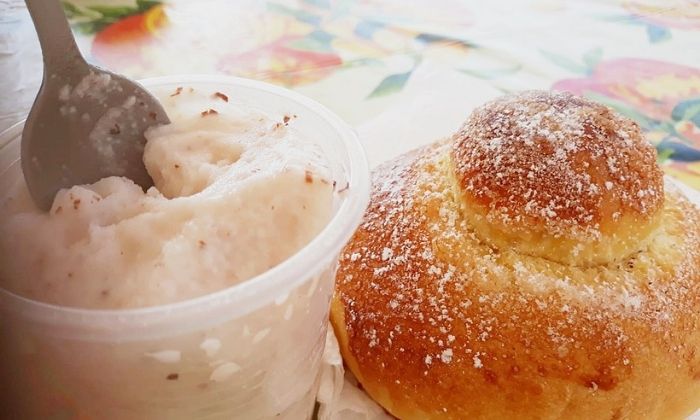
Picture Courtesy: Wikimedia
One of the most delicious and interesting breakfasts I had while travelling is without a doubt pistachio and almond granita in Sicily, Italy.
Granita is a semi-frozen dessert made from sugar, water and additional ingredients depending on the flavour you choose. It’s originally from Sicily, and the granita you find here is so much better than anywhere else. Compared to other granitas, the ones in Sicily are much thicker and creamier, almost resembling the texture of gelato. They’re usually artisanal made with proper ingredients added to the mix, instead of just the flavouring like you might find elsewhere in Italy.
You can get a granita in any flavour, but pistachio and almond are amongst the most classic Sicilian flavours. Pair it with a warm brioche, and you have the breakfast of champions right there.
One of the best granitas I’ve had was from Spinella Bar in Catania, one of the historical cafes in Catania. This artisanal granita had actual pistachio chunks in it, which added great flavour and texture.
You can find proper granita also in other parts of Italy, especially in Sicilian bars, but the real thing is easier to find in Sicily. So add Sicily to your Italy itinerary and start your hot summer days with this delicious breakfast!
8. Koulouri, Greece
Contributed by Chrysoula from Greece Travel Ideas

Koulouri also known as Koulouri Thessaloniki’s is a popular Greek breakfast on the go. It first appeared in the Byzantine era and especially in Constantinople and was brought to Thessaloniki by the refugees in 1922.
Koulouri is a round-shaped bread with a whole in the middle. It is soft inside and crunchy on the outside and it is covered with sesame. It is sold by street vendors everywhere in Greece and also in bakeries.
People buy it as a quick breakfast usually on their way to work. Newer versions of koulouri consist of koulouri with olives, cheese, cheese and bacon and many more tastes. They even sell it as a sandwich, they cut it in the middle and add cheese, turkey and many other ingredients.
You can find the traditional koulouri in street vendors but if you are in Athens you will find the best one in the Psirri neighborhood, in a shop called “To Koulouri tou Psirri” that has been making koulouri since the 1960s.
9. Bread with Hagelslag (chocolate sprinkles), Netherlands
Contributed by Dymphe from Dymabroad

“Dutch custom” by nosha is licensed under CC BY-SA 2.0
A typical breakfast in the Netherlands is bread with hagelslag. This is a breakfast dish that is very popular in the country, and both adults and children eat it. The dish started out in the year 1913, and nowadays it’s hard to imagine Dutch breakfast without it.
Hagelslag are small chocolate sprinkles with a cylindrical shape that are very tasty. The name of the chocolate sprinkles comes from the Dutch word for hail. People take a slice of bread, spread butter on the bread so that the sprinkles don’t fall off, and then put the chocolate sprinkles on top of it.
Hagelslag consists of chocolate, and there are several variants of it. There’s hagelslag that consists of milk chocolate, dark chocolate, white chocolate, and a mix of these types of chocolate. People prepare this breakfast themselves at home, and it is possible to buy hagelslag at every supermarket in the Netherlands.
10. Syrniki dish, Ukraine
Contributed by Anya from A Road is Calling

One of the best ways to get in a festive mood in Ukraine is to start a day with a hearty beautiful meal. While there are dozens of dishes to have for breakfast in Ukraine, I would love to talk about one of the most popular and favorite breakfasts for children and adults ‘syrniki’. The name comes from the word cheese and means cottage cheese fritters or pancakes.
This dish dates back to the ancient times of Kievan Rus’ when fermented milk products were used for the preparation of various dishes. Fermented cheese (which in appearance and taste was similar to modern cottage cheese) was one of the main ingredients in cooking and syrniki made with it quickly became very popular among the nobility and the poor peasants.
At that time though, syrniki was a rather simple dish. People ate it plain or with sugar. Sometimes they added sour cream or jam to enhance its flavor. Over the years, the recipe has changed and improved so many times that it brought syrniki to a completely new level.
Today, in many places around Ukraine, when someone is making syrniki, they follow a modern recipe. People nowadays use cheese with 7% – 18% fat, not sour or dry cheese as in the past. Also, instead of a lot of flour, they add semolina and vanilla. And instead of making them plain, they add dozens of fillings and toppings.
One of the cities where you can try the variety of syrniki is Lviv. There, you can find them with coconut and banana filling, with chocolate and apricots, pear and syrup, berries, whipped cream, melted chocolate, and various jams. The top three restaurants are Baczewski Restaurant, Svit Kavy, and Papi.
11. The Ulster Fry, Northern Ireland
Contributed by Allan from It’s Sometimes Sunny in Bangor

Northern Irish cuisine has a reputation for being greasy and unhealthy, which is true in parts, but the prime example of this is how this small country starts the day with the Ulster Fry. A staple for many people’s morning routine that is more likely to put others to sleep.
The Ulster Fry is a mix of processed meats and high carb breads all fried together and served with optional red or brown sauce, or maybe some baked beans. Tea or coffee on the side. There are similar ‘breakfasts’ and ‘fries’ throughout the British Isles, which would include similar items like bacon, sausages, mushrooms, and tomato, but the Ulster Fry is unique in the addition of a leavened soda bread, a potato bread which is a flatbread made from Ireland’s lifelong staple, the potato.
It also includes black pudding which is a bit like a regional blood sausage in the more local isles. It is also very simple to find for breakfast at pretty much every hotel and guesthouse in the country, as well as most cafes and greasy spoons, and a recommended Belfast chain would be Fed & Watered.
12. Cornetto e Cappuccino, Italy
Contributed by Claudia Tavani from My Adventures Across The World
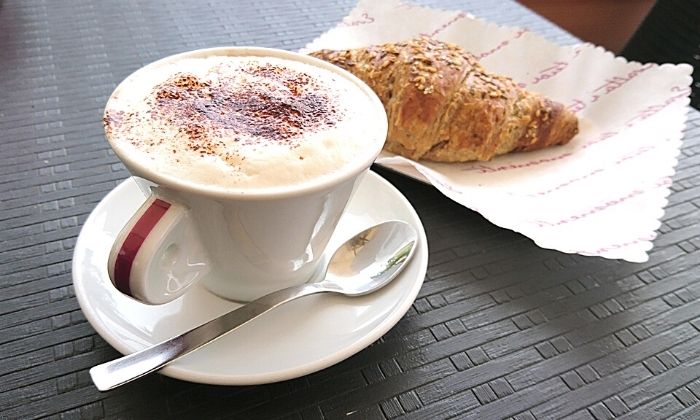
Locals favorite breakfast in Italy is “cornetto e cappuccino,” which is usually enjoyed at a bar – Italian for café. It’s not exactly the healthiest way to start a day – but alas, once in a while it’s great!
There is literally two components to this breakfast: Cornetto, a pastry which
will remind you of a French croissant in shape but which has a completely different taste and texture (it’s not as flaky or buttery); and cappuccino, which is steamed whole milk with milk froth on top and a shot of espresso coffee.
Cappuccino was accidentally invented by Marco d’Aviano, a capuchin friar, during a trip to Vienna. Displeased with the drink in fashion back then (coffee, obviously), he demanded milk to correct the taste and was pleased with the result – if anything because the color reminded him of his habit.
Today, cappuccino is still served in one size (only airports will offer different sizes) and the classic one is still made with whole milk; though “bars” are finally catering to vegans and lactose intolerants with soya and lactose free milk options.
Classic cornetto is plain, but locals enjoy various versions filled with vanilla custard, apricot jam and even chocolate or pistachio spread.
Traditional Breakfasts Around the World – Africa
13. Traditional Moroccan breakfast
Contributed by Jürgen & Martina from PlacesofJuma

One of the best and richest breakfasts ever, you will enjoy during a Moroccan trip! The Moroccan breakfast is a really delicious thing, colorful and varied. Basically, you’re served a variety of delicacies on a table, and you’re free to choose whatever you fancy. The small, colorful Moroccan bowls are also really appetizing, which makes the Moroccan breakfast a visual delight.
At breakfast time you will enjoy to get several dishes at the same time, and a few things belong on every table: typical Moroccan flat bread, goat cheese, butter, hard-boiled eggs, various olives, fresh vegetables, beans and fresh fruit – this things can almost always be found on a laid breakfast table. Less often, but sometimes, a breakfast soup is also served.
Moroccan breakfasts also include sweet dishes! Delicious pancakes, homemade cakes and sweet pastries are the highlights here. To drink, there’s usually the sweet Moroccan tea with mint or a strong coffee (with or without milk). To make sure that the vitamins are not in short supply, a freshly squeezed orange juice is always served.
Moroccan breakfast can be found in almost every riad in Morocco. For example, the Riad Irena in Marrakech is highly recommended for that.
Traditional Breakfasts Around the World – North America
14. Huevos Motuleños, Mexico
Contributed by Shelley from Travel To Merida

When visiting the Yucatan Peninsula, Mexico — especially Merida, known as the cultural capital of Yucatan — you’ll want to experience things unique to this area.
One of the best things to do in Merida is sample the most beloved Mexican breakfast in Yucatan, huevos motuleños (pronounced way-voes moe-two-len-yose). This is an egg breakfast made famous in the pueblo (small town) of Motul, Mexico, located about 45-minutes from Merida.
Though the combination of ingredients may seem bizarre, the dish is delicious and filling. It has many unique flavors in it, and is something you won’t find anywhere in Mexico outside the Yucatan Peninsula; though they have similar versions in Cuba and Costa Rica.
Huevos motuleños starts with about six tortillas laid out on a plate with pureed black beans and two sunny side up eggs placed on top. Peas, sweet plantains and diced ham (vegetarians can omit that) are then added. Finally, the whole dish gets smothered in salsa roja (mild red salsa), but each diner can add spicy habanero salsa if desired.
Although an unusual combination of ingredients, this is a rustic or farmer’s style dish. It is a hearty breakfast, enjoyed in both small towns and big cities throughout southeastern Mexico, and it will fill you up all day.
15. Guatemalan Breakfast

Contributed by Daria from The Discovery Nut
Guatemala has several types of breakfasts in different regions, but most of them contain the same ingredients of a typical Guatemalan breakfast (or desayuno típico in Spanish) that include refried beans, eggs, fried plantains, and tortillas.
Guatemalan breakfast tends to be on the heavy side, however, it can be modified depending on one’s preference. Other ingredients that could be also present depending on the region are salsa verde (green salsa), chorizo, pancakes and a small bowl of fresh fruits.
Papayas, mangoes and bananas grow in parts of Guatemala thanks to its warm tropical climate.
Eggs can be cooked in many different ways for a traditional Guatemalan breakfast. For example, huevos con cebolla o tomate (eggs with onion or tomatoes), are scrambled eggs that are cooked with “Pico de Gallo” that includes tomato, bell pepper and onion.
Another option is huevos rancheros, the original Guatemalan style where eggs are cooked in a skillet with a tomato, garlic and onion sauce and poached eggs.
One of Guatemala’s top exports, coffee is also a popular breakfast component. And if coffee is not your drink, you can also substitute it with juice.
16. Biscuits and Gravy, the USA
Contributed by Sydney from A World in Reach
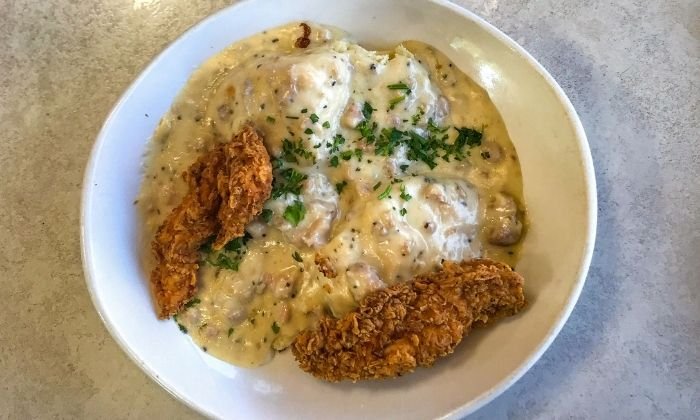
When mentioning biscuits and gravy to a non-American, it’s not uncommon to get some funny looks. Putting gravy on biscuits might seem like an abomination to some, but this Southern breakfast staple is a must-try when visiting the United States.
In the United States, biscuits aren’t the same sweet, hard treat that is typically found in the UK and other parts of Europe. Rather, they are fluffy, buttery, and savory. Gravy featured in this dish is typically made with white flour, milk, and grease from breakfast sausage or bacon. Bits of the cooked meat are sometimes included as well. When mixed together, these seemingly simple ingredients combine to make a delicious, savory gravy that pairs perfectly with warm buttermilk biscuits.
Biscuits and gravy date back to the American Revolutionary War, when food supplies were scarce. Biscuits and gravy was a cheap, filling meal that could fill someone up for a full day of work on a plantation. Today, the dish is most commonly found in the southern states. The dish is frequently featured on diner menus, and there’s nothing better than a delicious plate of biscuits and gravy from a local greasy spoon.
If you’re visiting one of the southern states (a perfect destination for a weekend trip in the USA), make sure to add a local diner to your itinerary so you can sample this authentic southern favorite.
17. New York City Bagels, the USA
Contributed by Eileen Gunn from FamiliesGo!
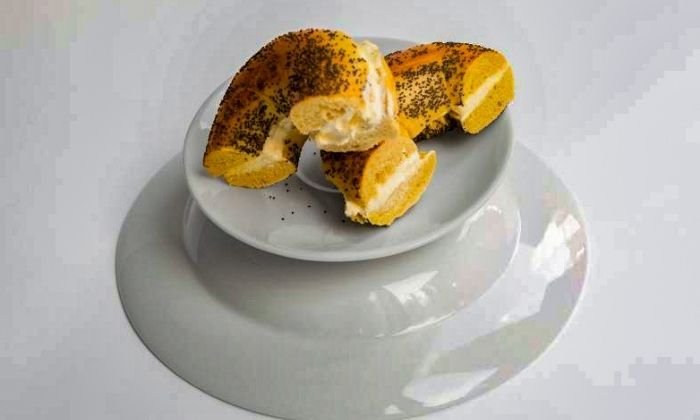
New Yorkers take our bagels seriously. We routinely ask political candidates how they like their bagel. One mayoral hopeful was almost laughed out of the race for saying she likes lox on a cinnamon-raisin bagel (seriously, who does that?)
Traditionally bagels are on the smaller side, dense and chewy. To get their shiny crust they have a dip in boiling lye before being baked. Traditional bagels are plain, egg, or topped with salt, onion, poppy seeds, sesame seeds or all of the above (the “everything”). We’re suspicious of any bagel that goes too far beyond these. Whole grain or rye is okay. Cinnamon-raisin is usually the only sweet. Blueberry or Asiago are beyond the pale; rainbows are a gimmick for tourists.
Some bagel places also make bialys, smaller, chewier cousins topped with bits of onion or garlic (and no lye bath). They’re very old-school. The traditional bagel topping is cream cheese and sliced lox, maybe with thinly sliced onion, which you’ll find at Jewish bakeries and delis like Black Seed, Zabar’s, Russ & Daughters, Shelsky’s and Kossar’s (read all about their great babka, too).
An authentic bagel or bialy nosh is an essential breakfast when you visit New York City.
18. Mangu, Dominican Republic
Contributed by Chris from Punta Cana Travel Blog

The typical breakfast in the Dominican Republic is Mangu (mashed plantains) and eggs with fried cheese or salami (or sometimes both). You can get this breakfast everywhere in the Dominican Republic, it doesn’t matter if it is a local food shack on the street or an international restaurant. If you eat it locally, you can get it usually for around 100 DOP, which is around 1.70 USD.
This breakfast is culturally significant for two reasons.
First, breakfast is an important dish in Dominican society, as dinner usually is very light. Therefore, especially for hard-working jobs, it is crucial to start the day with a hearty and filling meal.
Second, Mangu is made out of plantains, one of the most common local fruits. Each day, more than 7 million plantains are consumed in the country. The average Dominican eats plantains every day. Mangu is a particularly delicious form of it, as it is first cooked and then mashed until it is a creamy puree.
The other ingredients of the most common breakfast in the Dominican Republic are eggs (usually scrambled), salami (fried) and cheese, which is a particular local cheese that gets fried as well.
Usually, you can get a good Mangu with eggs, cheese and salami everywhere in the Dominican Republic – it doesn’t matter if you stay in Punta Cana, Santo Domingo or elsewhere in the country. Just check the nearest local restaurant or try it for breakfast in your hotel.
19. Malasadas, Hawaii
Contributed by Marcie from Hawaii Travel with Kids

One of the best things about Hawaii is that it’s truly a melting pot of lots of different cultures and that is really apparent when it comes to cuisine. In Hawaii, one of the most popular breakfast pastries are malasadas. These donuts actually originated in Portugal and were brought to Hawaii during the sugar plantation days and have been a staple of Hawaiian breakfasts ever since.
Traditional malasadas are basically large scoops of dough that are fried in oil and rolled in white sugar and sometimes cinnamon. They look like oversized donut holes. In recent years, Hawaii bakeries have started filling malasadas with custard creams (like mango, chocolate, guava, and coconut) for a completely new experience. Sometimes they are even rolled in li hing mui, a slightly sour/salty powder made from dried plums.
The best place to try malasadas in Hawaii is at Leonard’s Bakery on Oahu. But, be sure to get there early as the lines start at dawn and can easily wrap around the corner.
Traditional Breakfasts around the World – Central America
20. Gallo pinto, Costa Rica
Contributed by Haley from Barefoot Travel
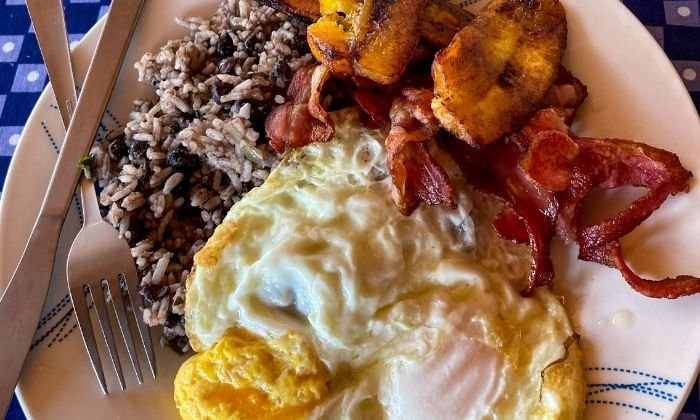
Gallo pinto is the traditional breakfast dish of Costa Rica. With a base of beans and rice, it’s quite simple, but also delicious! Gallo pinto is literally Spanish for “spotted rooster”, due to the speckled appearance the rice and beans get when cooked together. In the Guanacaste region of Costa Rica, the breakfast dish is made with red beans, and small red peppers. In other regions of the country, it’s made with black beans.
To prepare the dish, first the rice and beans are cooked separately. Then before serving, they are sauteed together. Typically, some combination of peppers, cilantro, and onion is sauteed with the rice and beans.
While the base of gallo pinto is beans and rice, while eating at typical restaurants (called sodas) in Costa Rica, there is usually the choice to add bacon, ham, bread, plantains, tortillas, and or avocado to the dish.
Nosara, Costa Rica is a beautiful beach town in Costa Rica with excellent food options. To get there, it is easiest to fly into the Liberia National Airport and take a rental car or shuttle. The best place to try gallo pinto in Nosara is Rosi’s Soda.
21. Saltfish Souse – Grenada
Contributed by Michele Peterson from A Taste for Travel

Dried and salted cod (also known as saltfish) has a long history in the Caribbean. It dates back to the 16th century when ships from Newfoundland and Nova Scotia in Canada would bring lumber and preserved fish to the Caribbean and return with rum, molasses, sugar and salt. The cod, which was rehydrated after it had been preserved by drying, was considered an inexpensive, high protein food to serve to slaves on the island plantations. Many of those traditional salted cod dishes can still be found throughout the Caribbean islands in a variety of recipes from ackee and saltfish in Jamaica to acras de morue.(fritters) in Guadeloupe and Martinique.
In Grenada, saltfish makes an appearance at breakfast in a dish known as saltfish souse. One of the most popular traditional breakfasts on Grenada, it’s often served with a bake (a round of fried dough), hard boiled eggs, a chunk of smoked herring and a steaming mug of coffee or cocoa tea. It’s made by rehydrating the salted cod and rinsing it multiple times before shredding it and tossing it in a vinaigrette with a mixture of thinly sliced onions, peppers and black pepper. The best place to sample this traditional Grenadian food is from a food vendor at St. Georges Market Square on the weekends, at Patrick’s Homestyle Cooking restaurant or as part of a Grenadian breakfast or brunch spread at a resort buffet.
Traditional Breakfasts Around the World – South America
22. Arepa de Huevo in Cartagena, Colombia
Contributed by Adam McConnaughhay from CartagenaExplorer.com

Arepas are a common breakfast food around Latin America, as are eggs around the world. However, in Cartagena, Colombia, these two breakfast favorites are combined to make something even more delicious.
The Arepa de Huevo combines the influences of indigenous people’s use of corn – African frying techniques, and the Spanish love of eggs. Made with yellow corn flour, the Arepa de Huevo is fried to a golden brown and filled with an egg and, traditionally, ground beef. It is actually more similar to an empanada than a traditional breakfast Arepa.
It’s also possible to get one with just the egg. At the restaurant Donde Magola, there are lots of different varieties stuffed with everything from shrimp to chorizo alongside the egg. There is even a festival every year in late February where different fry cooks compete for the best unique combination of fillings.
The Arepa de Huevo is a popular choice for breakfast on the go in Cartagena and is fairly unique to the Caribbean coast of Colombia. They can also be enjoyed as an afternoon snack or even dinner. They are best enjoyed from street stalls around Cartagena’s historic city center or at Donde Magola, and they are undoubtedly one of the best things to do in Cartagena.
23. Fried plantains & upe drink, Peru
Contributed by Anthony from Green Mochila
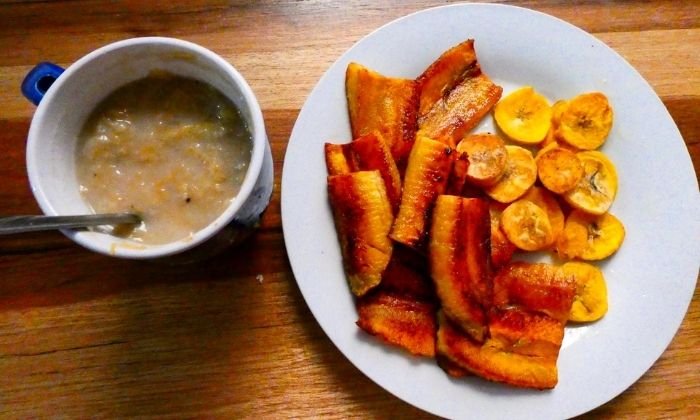
Plantain is a common staple food throughout Latin America alongside hit-makers like white rice, dark beans, beef and chicken. Similar to bananas, this yellow, green or sometimes reddish starchy fruit is cheap, versatile, and a great go-to for vegetarians in a land where vegetarians certainly need a go-to.
We fell in love with plantains over many Peruvian breakfasts served by chubby mamas in market halls. Breakfast in Peru is usually savoury and includes meat. In fact, meat is so important in the Peruvian cuisine that the vegetarian morning dish is called “Rice a la Cubana“. For the price of half a nothing, you can get your fill for the day or almost. Rice and meat are always accompanied by plantains in different forms: as plantain chips, as fried slices or as “tostones“, a thicker, round version.
Another way to have plantains for breakfast is in the shape of a warm drink called upe, typical of the region of Moyobamba. The plantains are grated and mixed with milk and/or water, then the drink is sweetened and traditionally enjoyed in the countryside with potato and white cheese.
They’re also very easy to cook, so have a go at our Peruvian plantain recipes.
24. Medialunas, Argentina
Contributed by Lindsey Puls from Have Clothes, Will Travel

A typical Argentine breakfast is a simple affair, consisting of coffee or mate with a “medialuna.” All the top places to visit in Argentina will have a panaderia (bakery) serving up freshly made medialunas in the morning.
Medialuna translates to half a moon, which is exactly the shape of this delicious pastry. Many may recognize medialunas as a croissant, but Argentina’s version is a bit sweeter, sometimes even having a bit of lemon zest in the dough. This makes them perfect to top with jams or dulce de leche (caramelized milk).
Some medialunas, called “Medialuna Rellenas”, will be filled with dulce de leche or chocolate! The other types of medialunas (that aren’t filled) are Medialuna de Manteca, which are medialunas made with butter, and Medialuna de Grasa, made with oil and are fluffier and flakier.
The medialuna originated in Europe and was brought with European immigrants to Argentina. It was supposedly created by the Austrians to taunt their Turkish enemies, as the crescent moon is a symbol of Islam.
25. Arepa, Colombia
Contributed by Venaugh from VeNaugh

Living in Bogotá, Colombia, a favourite tradition is to go to breakfast even though there are so many things to see and do in Bogotá! Arepas can be eaten as any meal or even just a snack in Colombia and can be made in countless different ways.
The base of the dough is usually made from cornmeal (yellow or white), flour, sugar, salt, and water or milk. A specific type called arepa de cuajada is made with a yellow cornmeal and the filling is a thick slab of cuajada (a type of cheese). This costs about $2,500 COP which is less than US$1.
Along the streets it is very easy to spot an arepa vendor who can have even more fillings including beans, meat, avocado, and rice. Some of the fancier vendors with more fillings can sell an arepa for $10,000 COP. No matter the place, there is a wide variety of sauces. Usually, people stand around the sauces pouring it on their arepa before every bite. Next time you’re in Colombia, don’t forget to try an arepa among many other traditional dishes.
26. Tapioca, Brazil
Contributed by Camila Neves from Travel Cami
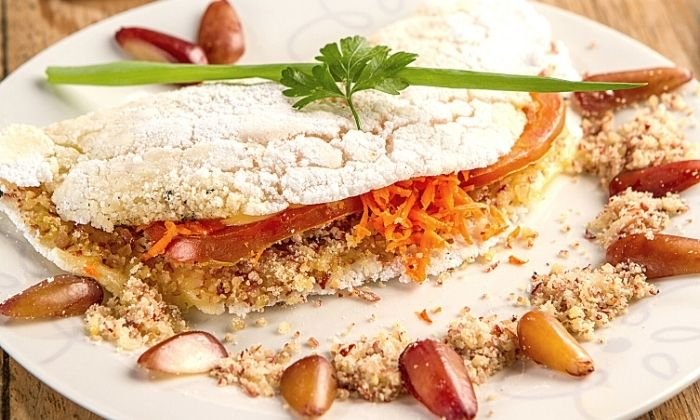
One of the most delightful breakfast dishes in Brazil, especially in the north, is tapioca.
Tapioca is a sort of small white pancake made of tapioca flour, which is a starch extracted from cassava root. The plant was brought to Brazil by the Portuguese during colonization and became an easy staple food.
It can be served sweet, with jam, chocolate, or condensed milk, or savory, with cheese, eggs, or ham. If you decide to try it, you will find tapioca in almost any hotel breakfast in the country. In North and Northeast Brazil, it is also common to find street vendors selling it.
Traditional Breakfasts Around the World – Oceania
27. Tropical breakfast in Samoa
Contributed by Tom & Zi from Craving Adventure

Samoa is a tiny tropical island nation in the Pacific, known for its laid back atmosphere, perfect golden-sand-beaches lined with palm trees, Polynesian hospitality, and a great food culture. Coconut is one of the main ingredients in many of their dishes. Breakfast is a big part of Samoan food culture, and is usually made up from a big spread of all sorts of tropical fruit, and traditional Samoan breads.
The most popular one is Fa’apapa (sweet coconut bread), which is to Samoans what toast with jam is to Americans, and it is as delicious as it sounds. They are made with flour, sugar, unsweetened coconut flakes and coconut milk. Mix them all together in a bowl to create the dough, toss it in the oven for 30-40 minutes, and enjoy!
An adaptation of Fa’apapa is Pani Popo (coconut rolls) which are made pretty similarly, except that you make the sweet coconut sauce separately from the dough, then use half of it in the dough and half of it as a sauce to pour over once the rolls are baked. A breakfast like this is standard in most hotels in the country, find the best accommodation options in Samoa here.
So this was a list of some of the famous breakfasts around the world.
These are just a few. With time I would like to add on to this list of breakfasts around the world. Do let us know your favourite breakfast in comments below. And also let us know about the most bizarre food item that you have eaten while travelling. For me it was rat meat in Arunachal Pradesh! I want to know yours!
Pin this for a later read!











0 Comments